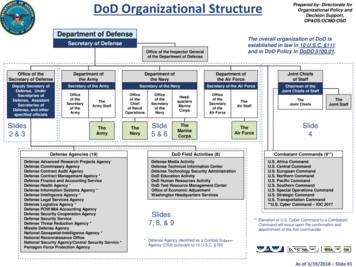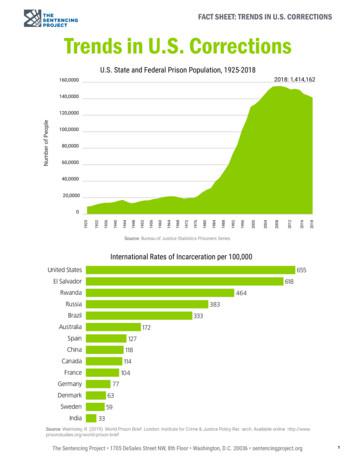Human Rights Defense Center - Prison Legal News
Human Rights Defense CenterDEDICATED TO PROTECTING HUMAN RIGHTSApril 22, 2013Submitted Online OnlyThe Honorable Julius GenachowskiChairmanFederal Communications Commission445 12th Street, S.W.Washington, DC 20554Re: Reply Comment in the Matter of Rates for Inmate Calling ServicesWC Docket No. 12-375Dear Commissioner Genachowski:On March 25, the Human Rights Defense Center (HRDC) submitted a comment concerningthe Commission’s Notice of Proposed Rulemaking on WC Docket No. 12-375, with respect toInmate Calling Services (ICS). Our comment provided updated (FY 2012) data on ICS ratesand commission percentages and amounts for the majority of state Departments of Corrections(DOCs) and the federal Bureau of Prisons. We now submit this reply comment to address issuesraised by other parties in their initial comments provided to the Commission.Several ICS providers, state DOCs and county sheriffs submitted comments opposing the ICSbenchmark rates urged by the Petitioners, 1 which would ensure that the costs of interstate callsfrom U.S. correctional facilities are just and reasonable. The content of this reply comment isbased on records obtained from governmental agencies, including ICS contracts, commissionrelated data and prison phone rates, as set forth in our March 25 comment. 2“Robust” Competition is a MythThe three ICS providers that dominate the market for state DOC prison phone services, GlobalTel*Link (GTL), Securus and CenturyLink, claim there is “robust” competition in the prison1See generally, CC Docket No. 96-128, Petitioners’ Alternative Rulemaking Proposal Regarding Issues Related toInmate Calling Services, filed Feb. 28, 2007 (“Alternative Wright Petition”).2Comments of the Human Rights Defense Center (HRDC) dated March 25, 2013.P.O. Box 2420Brattleboro, VT 05303Phone: 802.257.1342 Fax: 866.735.7136Email: pwright@prisonlegalnews.org
2phone industry. 3 For example, GTL mentions that “for larger contracts, it is typical for more thanfive or more [sic] service providers to submit bids.” 4Through our extensive research, which included submitting numerous public records requests togovernmental agencies, we obtained the current ICS contracts from the majority of states. Someof these contracts include RFPs and other bidding-related records. This documentation providesinstructive examples regarding the “competitive bidding” alleged by ICS providers: In Arizona the “competition” was anything but robust. Records indicate that for thestate’s current ICS contract (awarded in 2007), the three “offerors” were GTL, PCS(since acquired by GTL) and Evercom (at the time a division of Securus). 5 In Oklahoma’s 2011 ICS bidding process, four bidders represented three companies:Securus, GTL, VAC (owned by GTL) and CenturyLink. 6 In Alabama only GTL, Securus, Talton and CenturyLink bid on that state’s currentcontract, which was awarded to CenturyLink effective June 6, 2012. 7GTL, Securus and CenturyLink obfuscate their dominance in the market when they are awardedcontracts through subsidiary companies they have acquired – such as VAC (GTL), PCS (GTL),Embarq (CenturyLink), ICS (CenturyLink) and T-NETIX (Securus).When it comes to contracts with state DOCs, competition mainly exists between the “big three”companies: GTL, Securus and CenturyLink. Only four states do not have contracts with one ofthe big three companies: Hawaii (Hawaiian Telecom), Illinois (CCPS), Montana (Telmate) andOregon (Telmate). 8 Thus, the ICS industry is highly concentrated with only three companiescontrolling 92% of the market for state prison phone services. This constitutes an oligopoly,which is less competitive than a less concentrated market. According to Prof. Richard Culp,in writing about the private prison industry, “Oligopoly theory and industry life cycle theorysuggest that the remaining companies will be less competitive overall, seeking interdependentrelationships with their competitors to help secure their position now that industry growth rateshave cooled.” 9 In short, a highly concentrated market is inherently less competitive.Normally, “competitive” means a contract award goes to the bidder that offers an equivalentservice or product for the lowest price. In the ICS market, however, contract awards tend to go3Comments of CenturyLink dated March 25, 2013 at 4; Comments of Global Tel*Link Corporation dated March25, 2013 at 14; Comments of Securus Technologies, Inc. dated March 24, 2013 at i.4Comments of Global Tel*Link Corporation dated March 25, 2013 at 14.5Arizona Department of Corrections Procurement Services Memorandum re: RFP No. 060072DC – InmateTelephone System; specifically “Comprehensive Scores,” dated July 31, 2007. See Exhibit A, attached.6Oklahoma Department of Corrections to Department of Central Services, Central Purchasing Division re: RFQ#1310003272 Award Recommendation, dated Aug. 19, 2011. See Exhibit B, attached.7State of Alabama Department of Finance, Division of Purchasing Tele Services-Pay Inmate Contract NumberTA497 Bidding Sheet, unknown date. See Exhibit C, attached.8Comments of HRDC dated March 25, 2013.9Culp, Richard. “The Failed Promise of Prison Privatization,” Prison Legal News, Oct. 2011, p.1; available at:www.prisonlegalnews.org/23838 displayArticle.aspx.
3to the bidder that offers the highest percentage of gross profits or call revenue to the contractingagency; i.e., the highest commission rate. Thus, the ICS market is competitive only in the sensethat ICS providers are competing to provide the highest return to the government agencies thatcontract for prison phone services. Consequently this works to the detriment of the consumer,unlike in other competitive milieus that are based on traditional supply and demand.For example, in an award recommendation letter from the Oklahoma Administrator of Contractsand Acquisitions to the CPO of the Department of Central Services, the Administrator wrote,“As indicated in the request that was sent out, the final contract award recommendation is beingmade based upon the proposal that offered the highest revenue sharing rates per call throughoutthe [assumed ten-year] life of the contract.” 10 The Administrator recommended VAC for thecontract award and included a chart showing the commission offerings of the four biddersrepresenting three companies: Securus, GTL, VAC (owned by GTL) and CenturyLink.Other examples of ICS contracts being based on the highest commission percentage, rather thanthe lowest cost to the consumer, were included in PLN’s comprehensive April 2011 report on theprison phone industry. 11For example, “[W]hen Louisiana issued an RFP for prison phone services in 2001, it specifiedthat ‘[t]he maximum points, sixty (60) . shall be awarded to the bidder who bids the highestpercentage of compensation .,’ and that ‘[t]he State desires that the bidder’s compensationpercentages . be as high as possible.’” Also, “When the Alaska Dept. of Corrections (DOC)issued an RFP in 2007, bidders were rated on a point system with 60% of the evaluation pointsassigned to cost. The RFP explicitly stated that ‘[t]he cost proposal providing the largestpercentage of generated revenues . to the state will receive the maximum number of pointsallocated to cost.’” Additionally, “According to a March 13, 2007 memo from the [Alabama]Department of Finance, the RFP ‘proposed to award what amounts to an “exclusive franchise”to the successful bidder based on the highest commission rate paid to the State on revenuesreceived from users of the [prison] pay phones.’” 12This does not constitute “competition” – much less “robust competition” – as those terms aregenerally defined and understood outside the ICS market.Commissions Drive High Prison Phone RatesIn its comment, CenturyLink claims that “The rates and charges determined by facilities aredriven by the costs that facilities and ICS providers incur to provide ICS.” 13 Several providersgo into great detail in their comments concerning the costs of providing prison phone services,ranging from personnel expenses for call monitoring to site-specific equipment.10Oklahoma Department of Corrections to Department of Central Services, Central Purchasing Division re: RFQ#1310003272 Award Recommendation, dated Aug. 19, 2011.11Dannenberg, John E. “Nationwide PLN Survey Examines Prison Phone Contracts, Kickbacks,” Prison LegalNews, April 2011, p.1, 3-4; available at:www.prisonphonejustice.org/includes/ public/ mments of CenturyLink dated March 25, 2013 at 4.
4However, CenturyLink contradicts itself by further noting, “ICS providers are able to operatewith lower calling rates when site commissions are not required.” 14 CenturyLink then providesexamples (South Carolina and Michigan) that corroborate the data submitted in our commentregarding the link between ending commissions and lower, more affordable ICS rates. 15 Whilesome percentage of ICS call charges is needed to cover the operating costs of the phone serviceand profit for the provider, a significant portion of the revenue generated by ICS calls goes aboveand beyond what is necessary to provide the service, in the form of commissions – in an amountof more than 103 million annually in FY 2012, not including commission data for six states,jails, private prisons, juvenile facilities and immigration detention centers. 16Rehabilitative Programs Should Not Rely on Exorbitant ICS RatesWhen county sheriffs and state DOCs argue 17 that “loss or decrease of [ICS commissions] willnegatively affect necessary programs for rehabilitation of offenders and will potentially increaserecidivism,” 18 they are essentially saying that rehabilitative programs for prisoners (educationalopportunities and substance abuse treatment, for example) should be funded by price-gougingprisoners’ families through high phone rates, rather than through general funding from DOC andcounty jail budgets. Commenters that raise this argument fail to address the propriety of havingprisoners’ families fund rehabilitative programs through the high cost of prison telephone calls,which essentially amounts to a tax on ICS call recipients to pay for such programs.The Mississippi DOC’s comment mentions that state’s 60.5% commission rate and FY 2012commission total of 1,651,805.23 (both of which are consistent with our data), without which,it claims, up to six prison programs potentially could be curtailed. 19The Louisiana DOC “relies upon the commissions earned to provide security monitoring ofthe telephone calls made from the prisons, assist with operational costs and provide specializedoffender education,” 20 and also suggests that programs for prisoners would be cut absent ICScommissions. The Louisiana DOC claims that the rate reduction proposed in the AlternativeWright Petition “will force the discontinuance of some, if not all, offender programming andwill probably drive telephone providers out of the market.” 21 Yet how is it that the DOCs inNew York and seven other states that have banned ICS commissions are able to operate securefacilities while providing rehabilitative programs and affordable prison phone rates?It is the responsibility of correctional agencies and legislatures to provide rehabilitative programsfor prisoners; they were able to do so before entering into ICS contracts that provide commissionrevenue, and eight states continue to do so without accepting ICS commissions. The argument14Id. at 14.Comments of HRDC dated March 25, 2013.16Id., Exhibit C.17See, e.g., Comments of the Routt County Sheriff’s Office dated March 11, 2013 at 1; Comments of the San DiegoCounty Sheriff’s Department dated March 15, 2013 at 1; Comments of the California State Sheriffs’ Associationdated March 22, 2013 at 1; Initial Comments of Mississippi Department of Corrections (MDOC) dated February 14,2013 at 1.18Initial Comments of MDOC dated February 14, 2013 at 1.19Id.20Comments of the State of Louisiana Department of Public Safety and Corrections dated March 22, 2013 at 3.21Id. at 6.15
5that such programs may be eliminated or curtailed absent commission funding, which is mainlyderived by overcharging prisoners’ families for ICS phone calls, is a red herring that lacks merit.Moreover, there is no evidence correlating the amount of ICS commissions paid to state DOCsand jails with the amount actually spent on rehabilitative programs, nor is there any requirementthat ICS commission revenue be used to fund such programs in most cases.Prison Legal News’ Data is Reliable and AccurateThe ICS data collected by Prison Legal News (both in our April 2011 report that reflects 20072008 data 22 and our more recent research reflecting FY 2012 data 23 ) is reliable and accurate tothe extent that state Departments of Corrections, the federal Bureau of Prisons and ICS providershave supplied accurate information in response to our requests.GTL incorrectly contends that the earlier data provided by Prison Legal News is unreliable. 24GTL claims that “the [2011] PLN study . reflects incorrect rates” for several states; however,the “correct” rates that GTL cites are from 2010 or later, even though GTL counterintuitivelyacknowledges that PLN’s April 2011 data was collected from the years 2007-2008.Nor is GTL particularly forthcoming with its own ICS-related information. For example, GTLsuccessfully moved to seal its contract with the Mississippi Department of Corrections and theamounts of commissions paid to that agency, in a state court proceeding. When PLN requestedthose records, the MS DOC refused to produce same, citing the protective order entered uponGTL’s request in the court proceeding. As a result, PLN was forced to file suit in Hinds CountyChancery Court to obtain the requested records, 25 which we contended were public records thathad been improperly sealed. The case settled with PLN obtaining the requested records. Thisdemonstrates the efforts that PLN has undertaken to ensure we obtain accurate data.GTL notes that “the [2011] PLN study [analyzing 2007-2008 data] does not provide a currentlyaccurate picture of the inmate calling market,” for example, because it only analyzes traditionalcollect calling rates and not the other options offered by some facilities such as prepaid or debitcalling. 26 We selected a comparison of collect calling rates for our April 2011 report because 49state DOC systems offered ICS collect calls but not all provided debit or prepaid calling options.However, our most recent data – submitted as Exhibit B to HRDC’s March 25, 2013 comment –includes rate information and 15-minute total call costs for collect, prepaid and debit calls, basedon FY 2012 data. 2722Dannenberg, John E. “Nationwide PLN Survey Examines Prison Phone Contracts, Kickbacks,” Prison LegalNews, April 2011, p.1, 3-4; available at:www.prisonphonejustice.org/includes/ public/ s of HRDC dated March 25, 2013, Exhibits B and C.24Comments of Global Tel*Link Corporation dated March 25, 2013 at 26-27.25Prison Legal News v. Miss. DOC and Global Tel*Link, Hinds County Chancery Court (MS), Case No. 2009-391T/1.26Comments of Global Tel*Link Corporation dated March 25, 2013 at 26.27Comments of HRDC dated March 25, 2013.
6GTL contends that PLN’s information is “stale,” and that “accurate and up-to-date informationis available.” We agree that the data published in our April 2011 report is no longer timely andalso agree that more recent information is available – which is why we have provided updateddata (as of FY 2012) in our March 25, 2013 comment submitted to the Commission. 28Further Delay is Unwarranted and UnacceptableCenturyLink “recommends the establishment of an ICS Federal Advisory Committee (ICS FAC)to address the ICS issue.” 29 We strongly disagree with this approach. Consumers of ICS serviceshave waited ten years for the Commission to address the exorbitant phone rates charged by ICSproviders, and further delaying action on this issue through the appointment of a committee doesa disservice to the tens of thousands of consumers who have been negatively impacted by suchpredatory prison phone rates over the past decade. We therefore urge the FCC to act now.Thank you for your consideration of this reply comment; please feel free to contact us shouldyou require any additional information that we may be able to provide.Sincerely,Paul WrightExecutive Director, HRDCAttachments: Exhibits2829Id.Comments of CenturyLink dated March 25, 2013 at i.
RFP 060072DC -INMATE TELEPHONE SYSTEM -INFORMATION TECHNOLOGYCOMPREHENSIVE SCORESReevaluation of proposals 7/31/07OFFERORS' RAW SCORESIIASSIGNEDPOINTSGTLPCSEvercom(Securus)#1 - Cost and Commissions.400364 (1)160 (2)128 (3)364 (4)160 (5)128 (6)284336 (1) 200 (7)384 (2) 200 (8)376 (3) 200 (9)400 (4) 200(10)200 (5) 200(11)200 (6)#2 - Technical Requirements.250250250250#3 - Vendor Qualification Requirements.180180160180#4 - Implementation Plan.145145145145252525258.64.001000(4) 800(7)984(2) 800(8)976(3) 800(9)936(1) 800(10)800(5) 800(11)800(6)IICRITERIA#5 - Conformity To UTC's & Soecial T&C's.TOTALS:1,000.00(1)(4)(2)(5)(3)I(6)EXHIBIT A964964760760728728EACH OFFEROR'S TOTAL RAW SCORE FOR EACH CRITERION HAS BEEN TRANSFERRED TO THIS COMPREHENSIVE SHEET.DICCORDANCEH TRTAL RAW SCORE RECEIVED.THE OFFERORS ARE RA. ·Contracts Administration: .L!. -/-- t,4. od:Ld ManagerDate:da/oz
,)),/I"S!"IS ,'0:\':''';IHII :("""'t\1.\11'· F.\I.I.':o.:, ,,,'·EIC"IIISTAT .: (W (lKI.,\II( 1 1,\OKJ.,\1I0i\l,\ IJEP,\frn"':NT OF ('OIWEt 'TIONSEXHIBIT BAugust 19. 20 IILaura Bybee. CPODepartment of Central Services (O( 'S)Central Purchasing Division2401 N. Lincoln Blvd . Suite 116Oklahoma City. OkJahon;a 73105Ref: RFQ# 1310003272 Award Recommendation------- 4--- --- ------------The Department of Corrections (DOC) has completed the tinal phase of evaluating theproposals foroftcnder phone sl!rvices. Throughout the phases of the evaluation processthe scores from all ti.mr of thesl! suppliers were very competitive with a small amount ofditlcrence hetween the individual scores. As you know. the tinal step was a 2 nd requesttor hest otlcrs that was sent out to all ! ulr of Ihe competing suppliers. As indicated in therequest that was sent out. the tinal contract award recommendation is being made basedupon the proposal that offered the highest revellue sharing rates per call throughout thelife of the contract. Attached to this letter you will lind a spreadsheet showing the tinalcomparisons of the proposed revenue sharing rates Illf each the vendors. [)()C \\lnuldlike to recommend that the tinal award Ii.lr ollcnder telephone services(RFQ#I 3 10(03272) be mude to Value Added Communications.orEnclosed you will lind the all of Ihe evaluation documents from the evaluation team.additional information is needed. please let me knO\\:.IfSincerely. na 'lrulorContracts and Acquisitions:, IIMI\I.un"t.t IItEU hoi"; \\ I' ,. I·, f'" t, IU.'II mn -hi \1,. HI \ ( Ir\, f )1\1,tI,I\1';'tt ei I un. tU",m . , e.!'.! · ,u I ,\ IU-.! I''::.,"!",,,
Contract YearInitial Year2nd Year3rdYear4th Year5th Year6th Year7th Year8th Year9th Year10th YearTotalsVACSecurus - OriginalCommlS per 4.0074.0074.0075.0076.0077.0078.0079.00Ext. r S/eallExt. TdtalFee0.781,097,071.564.750.781,097,0 1.56 4.750.784.751,097,0 .1.560.784.751,097, 1.560.784.751,097, 337,789.70Est. VendorsActual allS per 303.002.303.002.303.002.303.002.30Est. VendorsActual Cost2.972.972.972.972.972.972.972.972.972.97CommlS per 6.6776.6776.6776.6776.6776.6776.6776.67Ext. 0.700.700.700.700.700.700.700.700.700.70Ext. 54.754.754.754.75Est. VendorsActual tFee4.754.754.754.754.754.754.754.754.754.75Est. VendorsActual act YearInitial Year2nd Year3rd Year4th Year5th Year6th Year7th Year8th Year9th Year10th YearTotalsGTlCommlcallS ing Is based on1,406,502 calls (2009Data,.lA,"tAU.:4F.' .::y:;aazs;q:?44 a t .50Ext. Total Vendor 2.090.7053.227,922.090.70532,279,22D.90Centurylink - AiExt. Tot 1II991,583. 1I991,583. 5.0065.0067.0067.0067.0067.0067.0067.0067.00Ext. 1.051.051.050.990.990.990.990.990.990.99Ext. 81.392.436.981,392,436.9814,177,540.16
-- . -- Pr: c,, ""GTL--,r1I'-Numbl ollnm.tnSO 39PhoneIX25.eea 00 X0.- 1.2: :; ; X4I' J-',385 "-"-tIgec;u.ronteeEstim.ted Revenue10 OOO X 120.000 S12.0005061,79398,Gr1Ind TOIIISecurus-Number of InmatesDays25.668.00 XX 365To1al4.684.41000PercentageGuanit1leeEstimated Revenue0 250% X 120.000PucIic: """'-Grand Total 3004.684.710.00TaltonProposed Perdetm rate-SO 544PhonesNumberXor InmateoD. 25.668.00 X365 Total5.096.63808 Totll5.358.96504 P.centageGuatanteeE,timated Revenue100 000% X S120.000Grand Total120.0005.216.638 osCentury Linkp,OI OHd Pit'do,m ,a,.so 572Numblt'Xor Inmat.,25.MB 00 XDI 385P .centag.Guaranleeeatlm.ted Rev.nu.120.00087699% X SGrand TotalEXHIBIT CJJctem rateSO 500"""'-105.2395.464.203 84
Apr 22, 2013 · Tel*Link (GTL), Securus and CenturyLink, claim there is “robust” competition in the prison 1 See generally, CC Docket No. 96-128, Petitioners’ Alternative Rulemaking Proposal Regarding Issu
The prison population stood at 78,180 on 31 December 2020. The sentenced prison population stood at 65,171 (83% of the prison population); the remand prison population stood at 12,066 (15%) and the non-criminal prison population stood at 943 (1%). Figure 1: Prison population, December 2000 to 2020 (Source: Table 1.1) Remand prison population
Defense Advanced Research Projects Agency. Defense Commissary Agency. Defense Contract Audit Agency. Defense Contract Management Agency * Defense Finance and Accounting Service. Defense Health Agency * Defense Information Systems Agency * Defense Intelligence Agency * Defense Legal Services Agency. Defense Logistics Agency * Defense POW/MIA .
Rights and gendeR in Uganda · 3 Rights & Human Rights Background Rights The law is based on the notion of rights. Community rights workers need to understand what rights are, where rights come from, and their own role in protecting and promoting rights. Community rights worker
A Human Rights Perspective by David Shiman Raising Children with Roots, Rights and Responsibilities: Celebrating the UN Convention on the Rights of the Child by Lori DuPont, Joanne Foley, and Annette Gagliardi Lesbian, Gay, Bisexual, and Transgender Rights: A Human Rights Perspective by David M. Donahue The Human Rights Education Handbook:
Research, Development, Test and Evaluation, Defense-Wide Defense Advanced Research Projects Agency Volume 1 Missile Defense Agency Volume 2 . Defense Contract Management Agency Volume 5 Defense Threat Reduction Agency Volume 5 The Joint Staff Volume 5 Defense Information Systems Agency Volume 5 Defense Technical Information Center Volume 5 .
make up the International Bill of Human Rights. The provisions of the two Covenants, as well as other human rights treaties, are legally binding on . of their human rights, for example marriage and the family. 6 WOMEN’S RiGHTS ARE HUMAN RiGHTS The Convention defines d
prison. By 2004, people convicted on federal drug offenses were expected to serve almost three times that length: 62 months in prison. At the federal level, people incarcerated on a drug conviction make up nearly half the prison population. At the state level, the number of people in prison for drug offenses has increased nine-
Prison level performance is monitored and measured using the Prison Performance Tool. The PPT uses a data-driven assessment of performance in each prison to derive overall prison performance ratings. As in previous years, data-driven ratings were ratified and subject to in depth scrutiny at the moderation process which took place in June 2020.























